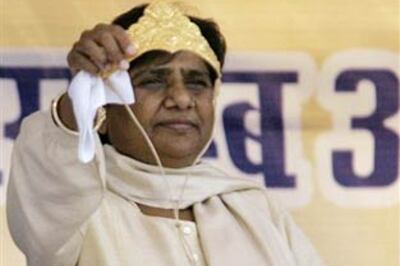
views
Prime Minister Narendra Modi in a televised speech on Wednesday announced that India had joined the elite club of space powers by shooting down a low earth orbit satellite with an anti-satellite missile or A-SAT.
India is the fourth country to have tested such an anti-satellite weapon after the US, Russia and China, the PM said, addressing the nation on the success of what he called "Mission Shakti.
"The pre-fixed target was destroyed by the A-SAT in just three minutes. With this, India has established itself as a space superpower. Mission Shakti was a difficult operation but a huge success," the Prime Minister added.
Mission Shakti, which was led by the Defence Research and Development Organisation, was aimed at strengthening India's overall security, he said.
Here are the frequently asked questions on Mission Shakti:What was the test?
On March 27, 2019 India conducted Mission Shakti, an anti-satellite missile test, from the Dr. A P J Abdul Kalam Island launch complex. This was a technological mission carried out by DRDO. The satellite used in the mission was one of India’s existing satellites operating in lower orbit. The test was fully successful and achieved all parameters as per plans. The test required an extremely high degree of precision and technical capability.
The significance of the test is that India has tested and successfully demonstrated its capability to interdict and intercept a satellite in outer space based on complete indigenous technology.
With this test, India joins an exclusive group of space faring nations consisting of USA, Russia and China. Which satellite was used?
The satellite used was an Indian satellite. Which Missile/Interceptor was used?
The DRDO’s Ballistic Missile Defence interceptor was used, which is part of the ongoing ballistic missile defence programme. There are other ways to demonstrate ASAT capabilities such as "fly-by tests” and Jamming. Why has India used the particular technology of Kinetic Kill?
This is a technology where we have developed capability. Space technologies are constantly evolving. We have used the technology that is appropriate to achieve the objectives set out in this mission. Does the test create space debris?
The test was done in the lower atmosphere to ensure that there is no space debris. Whatever debris that is generated will decay and fall back onto the earth within weeks. Why did India do the test?
1. India has a long standing and rapidly growing space programme. It has expanded rapidly in the last five years. The Mangalyaan Mission to Mars was successfully launched. Thereafter, the government has sanctioned the Gaganyaan Mission which will take Indians to outer space.
2. India has undertaken 102 spacecraft missions consisting of communication satellites, earth observation satellites, experimental satellites, navigation satellites, apart from satellites meant for scientific research and exploration, academic studies and other small satellites. India’s space programme is a critical backbone of India’s security, economic and social infrastructure.
3. The test was done to verify that India has the capability to safeguard our space assets. It is the Government of India’s responsibility to defend the country’s interests in outer space. Why was the test done now?
The tests were done after we had acquired the required degree ofconfidence to ensure its success, and reflects the intention of the government to enhance India’s national security. India has seen an accelerated space development programme since 2014. Is India entering into an arms race in outer space?
1. India has no intention of entering into an arms race in outer space. We have always maintained that space must be used only for peaceful purposes. We are against the weaponization of Outer Space and support international efforts to reinforce the safety and security of space based assets.
2. India believes that Outer space is the common heritage of humankind and it is the responsibility of all space-faring nations to preserve and promote the benefits flowing from advances made in space technology and its applications for all.
3. India is a party to all the major international treaties relating to Outer Space. India already implements a number of Transparency and Confidence Building Measures(TCBMs) – including registering space objects with the UN register, prelaunch notifications, measures in harmony with the UN Space Mitigation Guidelines, participation in Inter Agency Space Debris Coordination (IADC) activities with regard to space debris management, undertaking SOPA (Space Object Proximity Awareness and COLA (Collision Avoidance) Analysis and numerous international cooperation activities, including hosting the UN affiliated Centre for Space and Science Technology Education in Asia and Pacific. India has been participating in all sessions of the UN Committee on the Peaceful Uses of Outer Space.
4. India supported UNGA resolution 69/32 on No First Placement of Weapons on Outer Space. We see the No First Placement of weapons in outer space as only an interim step and not a substitute for concluding substantive legal measures to ensure the prevention of an arms race in outer space, which should continue to be a priority for the international community.
5. India supports the substantive consideration of the issue of Prevention of an Arms Race in Outer Space (PAROS) in the Conference on Disarmament where it has been on the agenda since 1982. What is the international law on weapons in outer space?
1. The principal international Treaty on space is the 1967 Outer Space Treaty. India is a signatory to this treaty, and ratified it in 1982. The Outer Space Treaty prohibits only weapons of mass destruction in outer space, not ordinary weapons.
2. India expects to play a role in the future in the drafting of international law on prevention of an arms race in outer space including inter alia on the prevention of the placement of weapons in outer space in its capacity as a major space faring nation with proven space technology.
3. India is not in violation of any international law or Treaty to which it is a Party or any national obligation. Is the test directed against any country?
1. The test is not directed against any country. India’s space capabilities do not threaten any country and nor are they directed against anyone.
2. At the same time, the government is committed to ensuring the country’s national security interests and is alert to threats from emerging technologies. The capability achieved through the Anti-Satellite missile test provides credible deterrence against threats to our growing space-based assets from long range missiles, and proliferation in the types and numbers of missiles.




















Comments
0 comment